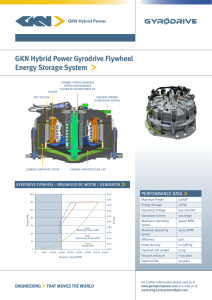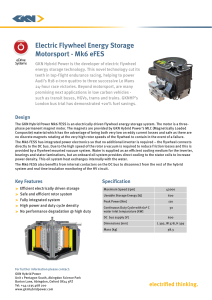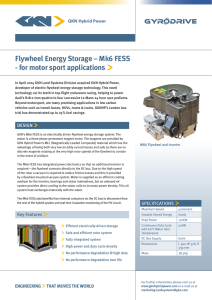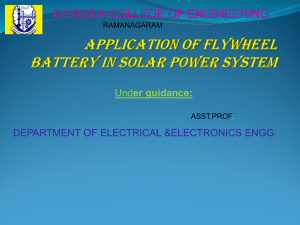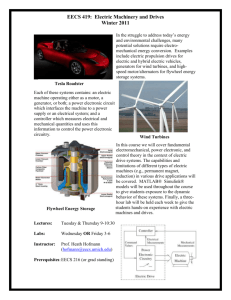Research Journal of Applied Sciences, Engineering and Technology 5(24): 5598-5601,... ISSN: 2040-7459; e-ISSN: 2040-7467
advertisement
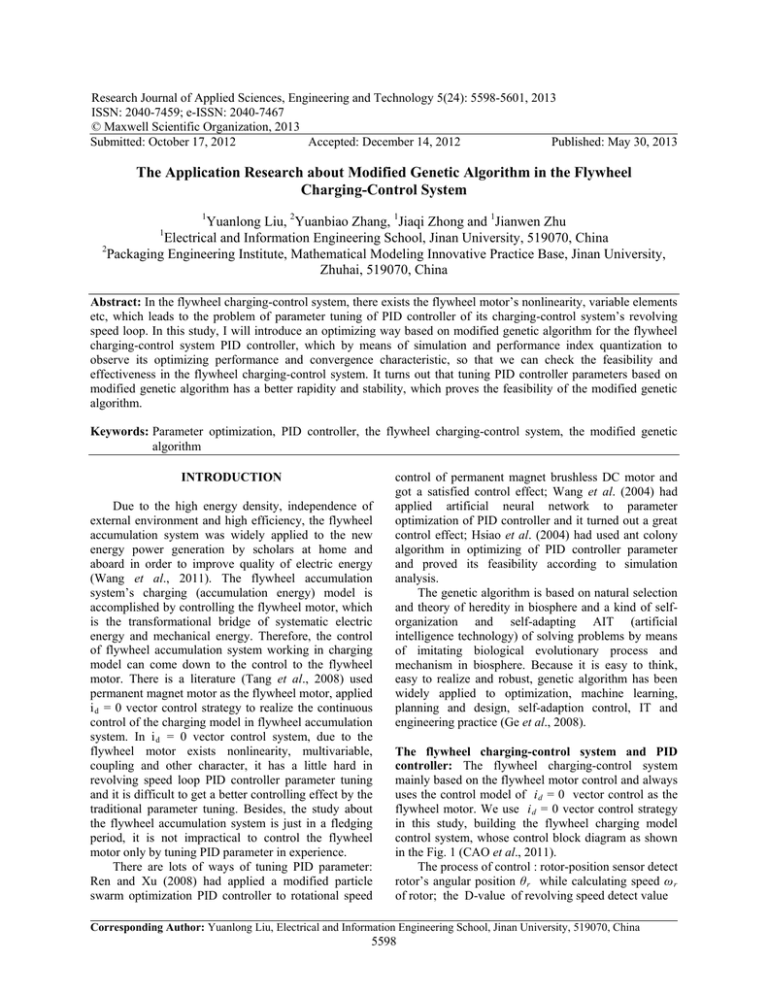
Research Journal of Applied Sciences, Engineering and Technology 5(24): 5598-5601, 2013 ISSN: 2040-7459; e-ISSN: 2040-7467 © Maxwell Scientific Organization, 2013 Submitted: October 17, 2012 Accepted: December 14, 2012 Published: May 30, 2013 The Application Research about Modified Genetic Algorithm in the Flywheel Charging-Control System 1 Yuanlong Liu, 2Yuanbiao Zhang, 1Jiaqi Zhong and 1Jianwen Zhu 1 Electrical and Information Engineering School, Jinan University, 519070, China 2 Packaging Engineering Institute, Mathematical Modeling Innovative Practice Base, Jinan University, Zhuhai, 519070, China Abstract: In the flywheel charging-control system, there exists the flywheel motor’s nonlinearity, variable elements etc, which leads to the problem of parameter tuning of PID controller of its charging-control system’s revolving speed loop. In this study, I will introduce an optimizing way based on modified genetic algorithm for the flywheel charging-control system PID controller, which by means of simulation and performance index quantization to observe its optimizing performance and convergence characteristic, so that we can check the feasibility and effectiveness in the flywheel charging-control system. It turns out that tuning PID controller parameters based on modified genetic algorithm has a better rapidity and stability, which proves the feasibility of the modified genetic algorithm. Keywords: Parameter optimization, PID controller, the flywheel charging-control system, the modified genetic algorithm INTRODUCTION Due to the high energy density, independence of external environment and high efficiency, the flywheel accumulation system was widely applied to the new energy power generation by scholars at home and aboard in order to improve quality of electric energy (Wang et al., 2011). The flywheel accumulation system’s charging (accumulation energy) model is accomplished by controlling the flywheel motor, which is the transformational bridge of systematic electric energy and mechanical energy. Therefore, the control of flywheel accumulation system working in charging model can come down to the control to the flywheel motor. There is a literature (Tang et al., 2008) used permanent magnet motor as the flywheel motor, applied i d = 0 vector control strategy to realize the continuous control of the charging model in flywheel accumulation system. In i d = 0 vector control system, due to the flywheel motor exists nonlinearity, multivariable, coupling and other character, it has a little hard in revolving speed loop PID controller parameter tuning and it is difficult to get a better controlling effect by the traditional parameter tuning. Besides, the study about the flywheel accumulation system is just in a fledging period, it is not impractical to control the flywheel motor only by tuning PID parameter in experience. There are lots of ways of tuning PID parameter: Ren and Xu (2008) had applied a modified particle swarm optimization PID controller to rotational speed control of permanent magnet brushless DC motor and got a satisfied control effect; Wang et al. (2004) had applied artificial neural network to parameter optimization of PID controller and it turned out a great control effect; Hsiao et al. (2004) had used ant colony algorithm in optimizing of PID controller parameter and proved its feasibility according to simulation analysis. The genetic algorithm is based on natural selection and theory of heredity in biosphere and a kind of selforganization and self-adapting AIT (artificial intelligence technology) of solving problems by means of imitating biological evolutionary process and mechanism in biosphere. Because it is easy to think, easy to realize and robust, genetic algorithm has been widely applied to optimization, machine learning, planning and design, self-adaption control, IT and engineering practice (Ge et al., 2008). The flywheel charging-control system and PID controller: The flywheel charging-control system mainly based on the flywheel motor control and always uses the control model of i d = 0 vector control as the flywheel motor. We use i d = 0 vector control strategy in this study, building the flywheel charging model control system, whose control block diagram as shown in the Fig. 1 (CAO et al., 2011). The process of control : rotor-position sensor detect rotor’s angular position θ r while calculating speed ω r of rotor; the D-value of revolving speed detect value Corresponding Author: Yuanlong Liu, Electrical and Information Engineering School, Jinan University, 519070, China 5598 Res. J. Appl. Sci. Eng. Technol., 5(24): 5598-5601, 2013 Fig. 1: The flywheel motor vector control block diagram based on i d = 0 and set value is used to be input of speed controller and output axis q voltaic set value i* q ; detecting detect values of axis d and d: i d : and i q , which are abc/dq coordinate transformed from stator current i α , i b , comparing the set value of axis d, q and the detect value; then output voltage values u d and u q by separate current PI controller and get mixed space voltage vector which are dq/abc coordinate transformed from u α , u b , u c , form PWM control signal to realize control of electromechanical speed and torque. In the flywheel charging-control system, inputting control system the D-value of revolving speed by PID controller, as the system’s input end, PID controller’s performance has a major effect on system control effect. Therefore, it is important to optimize the flywheel motor's PID controller for increase the performance of the flywheel charging-control system. PID controller is made of proportion, integration and differentiation element. According to theory of PID controller’s control algorithm, it combines the proportion, integration and differentiation linearly and forms controlled variable, so that we can control the controlled object. The relation between PID controller’s output and the deviation signal can be shown in Eq. (1): t y (t ) = K p e(t ) + K i ∫ e(t )dt + K d 0 de(t ) dt where, y(t) = The output of controller K p = The proportion coefficient K i = The integration coefficient K d = Differential coefficient e(t) = The input of controller GENETIC ALGORITHM (1) Coding, population initialization Calculating individual fitness Selection Cross over Mutation No End Yes Output Fig. 2: The flow of the SGA fittest, it has evolved a better approximate solution from generation to generation. In every generation, select individual by individual fitness in problem area and with the help of Natural Genetics’ genetic operators to do crossover and mutation to produce population which stands for new disaggregation. This process will lead population to be like natural evolution, the later one is more adaptable to environment than old one and it can regard as the approximate optimal solution of problems according to the decoding of the last generation population’s optimal individual (Ge et al., 2008). The flow of SGA (standard genetic algorithm) is shown as Fig. 2 (Ge et al., 2008): The design of modified GA (genetic algorithm) PID controller: The main step of PID controller parameter tuning based on modified GA is: GA (genetic algorithm) sets out from a population in the name of problematic possible potential Step 1: disaggregation and a population is made up of amount gene coding individual. Every individual is a characteristic entity. After the first population coming into being, according to the principle of survival of 5599 Encoding: Before optimizing parameter, GA codes the variables, forming a certain length of character string. In this study, we use realnumber encoding, GA based on real-number Res. J. Appl. Sci. Eng. Technol., 5(24): 5598-5601, 2013 encoding can greatly increase accuracy and convergence rate of solution, which is convenient for research in large space; it not only gets over the Hamming cliffs problem that binary coding causes, but also have fine adjustment function. In order to get the optimal PID regulate parameter, define chromosome code as Eq. (2): = E G [ K pG KiG K d G ] ∈ R3 neighboring individual i and individual i + 1 are shown as Eq. (6): TE (i,:) α * KPID(i + 1,:) + (1 − α )* KPID(i,:) = = (i + 1,:) α * KPID(i,:) + (1 − α )* KPID(i + 1) TE Crossover probability is p c and defined as Eq. (7): pc1 f ' < f avg ' pc = ( pc1 − pc 2 )( f − f avg ) , f ' ≥ f avg pc1 − f max − f avg (2) where, E = Code G = Tab of individual Step 6: K p1 K i1 K d 1 2 2 2 K p Ki K d N N N K K K i d p ∫ ∞ 0 (ω1 e(t ) + ω2u 2 (t ) + ω4 y (t ) − y (t − 1) )dt + ω3tu = F ∫ 0 (ω1 e(t ) + ω2u (t ) + ω4 y (t ) − y (t − 1) )dt + ω3tu 2 where, ω 1 = 0.999, ω 2 = 0.001, ω 3 = 2.0, ω 4 = 100. (8) where p m1 = 0.1, p m2 = 0.001: (4) When PID control overshoots, F is shown as Eq. (5): ∞ Variation. First of all, randomly choose an individual in colony, as for the chose individual, randomly change one character’s value in the string according to a certain probability, variation probability is shown as Eq. (8): pm1 f ' < f avg pm = ( pm1 − pm 2 )( f max − f ' ) , f ' ≥ f avg pm1 − f max − f avg (3) Step 3: Calculating fitness: Fitness function shows the adaptation ability of every individual, the fitness function's definition mode is different while the problem is different, in this study, we use fitness function Fitness = 1/F and F is target function. When PID control does not overshoot, F is shown as Eq. (4): = F (7) where, p c1 = 0.9, p c2 = 0.6. Step 2: Producing initial colony: Randomly produce N initial character strings, every string is individual or a chromosome. N individuals consist of a colony. GA set these N strings as initial point to start iteration: E1 2 E = = KPID N E (6) (5) = Kp ( K p max + K p min 2 Ki max + Ki min ) + ( K p max − K p min )*( β − 0.5) (9) ) + ( Ki max − Ki min )*( β − 0.5) 2 K d max + K d min = Kd ( ) + ( K d max − K d min )*( β − 0.5) 2 = Ki ( where, β ∈ [0 1] K p max and K p min K i mix and K i min K d max and K d min = A random number = The upper and lower limit of gene Kp = The upper and lower limit of gene Ki = The upper and lower limit of gene Kd Step 7: Convergence estimate: If it reaches convergence standard, then using the string Step 4: Selection: Using elite selection combined with which has highly value of adaptation serves as roulette, if the fitness value of the optimal searching result; or return to step 3 and repeat individual in the next generation is less than the process above. what in current generation, then copying the Step 8: Decoding: Decode the optimal string into optimal individual or individuals whose realistic physical parameter. In this study, we adaptation value was more than the next use real-number encoding which means generation and replace randomly or replace the needn’t decode. So the optimal individual we worst corresponding quantity individual in got are PID three parameters K p , K i , K d . next generation. Step 5: Crossover: For the checked individual, SIMULATION REALIZATION according to an interleaved mode way to AND ANALYSIS exchange corresponding gene of two strings, produce two new individual, which combine According to the research result, we would know the performances of their elder generation. The the flywheel motor could be presented as a secondarithmetic crossed method in this study, the 5600 Res. J. Appl. Sci. Eng. Technol., 5(24): 5598-5601, 2013 rapidity; overshoot, the number of oscillation is 0, meaning it has perfect stability. 1 0.9 CONCLUSION Best J 0.7 0.6 0.5 0.4 0.2 0.1 0 0 2 1 3 4 7 6 5 Times(s) 8 9 It is necessary for the PID controller, if it is supposed to get a better control effect, to adjust 3 control issues of proportion, integration and differential. The modified GA can solve the problems of PID parameters optimization in the flywheel chargingcontrol system which has nonlinearity, variable elements and other characteristic. Due to the modified GA not only inherit intrinsic simple thought, easy to realize, the obvious robustness and other characters, but also has a great improvement in veracity than the traditional GA, there is a better development space in the flywheel charging-control system. 10 Best J Fig. 3: The flywheel motor’s step response curve of modified GA 24 23 22 21 20 19 18 17 16 15 14 REFERENCES 0 10 20 30 40 50 60 Times 70 80 90 100 Fig. 4: The optimal curve of target function Table 1: The control effect of modified GA for the flywheel motor t r (s) t s (s) σ% μ 24 24 0 0 order system and the flywheel charging-control system transfer function (Wang et al., 2007) is shown as Eq. (10): G (s) = 1.6 s 2 + 2.584 s + 1.6 (10) Taking of individual number N as 30, evolution algebra T, after 100 generation’s evolution and we can know the optimal parameter K p is 1.6398, K i is 0.3704, K d is 0.9896 and the optimal value F of target function is 14.6527. Figure 3 is the flywheel motor’s step response curve of modified GA, Fig. 4 is the optimal curve of target function. Now taking rise time t r , overshoot σ%, accommodation time t s (±5%), the number of oscillation μ as indicator of the effect measure and the values are shown in Table 1: According to Table 1 and Fig. 3, we can know: modified GA absolutely can optimize the flywheel charging-control system and the rise time and accommodation time is short, which has a better CAO, W., L. Weihua, W. Lixin and F. Zhenlin, 2011. Application research of artificial bee colony algorithm to flywheel charging control system. East China Electric Power, pp: 1500-1504. Ge, J., Q. Yuhui, W. Chunming and P. Guolin, 2008. Summary of genetic algorithms research. Application Research of Computers, 10(10): 2911-2916. Hsiao, Y.T., C. Cheng-Long and C. Cheng-Chih, 2004. Ant colony optimization for designing of PID controllers. Proceeding of IEEE International Symposium on Computer Aided Control Systems Design, pp: 321-326. Ren, Y. and X. Xu, 2008. Optimization research of PSO-PID algorithm for the design of brushless permanent magnet machines. Proceeding of 5th IEEE International Symposium on Embedded Computing. Beijing, pp: 26-30. Tang, S., L. Zhixiong and J. Yu, 2008. Charging and discharging controller designing and modeling of Flywheel Battery based on SIMULINK. Microcomput. Inform., pp: 184-186. Retrieved from: http:// en. cnki. com. cn/ Article_ en/CJFDTOTAL- WJSJ20083 4081.htm. Wang, G., C. Liangyi, Z. Faquan et al., 2007. Design of a fly wheel control system for space borne electrooptical tracking system. Control Autom., pp: 1415, 24. Wang, J., W. Yongji and W. Shuyun, 2004. PID parameter self-tuning and real-time control based on dynamic neural network. Syst. Eng. Electron., pp: 777-779. Wang, L., L. Weihua and W. CAO, 2011. Application and prospect analysis of flywheel energy storage technology in the performance of wind power. East China Electric Power, pp: 450-454. 5601
